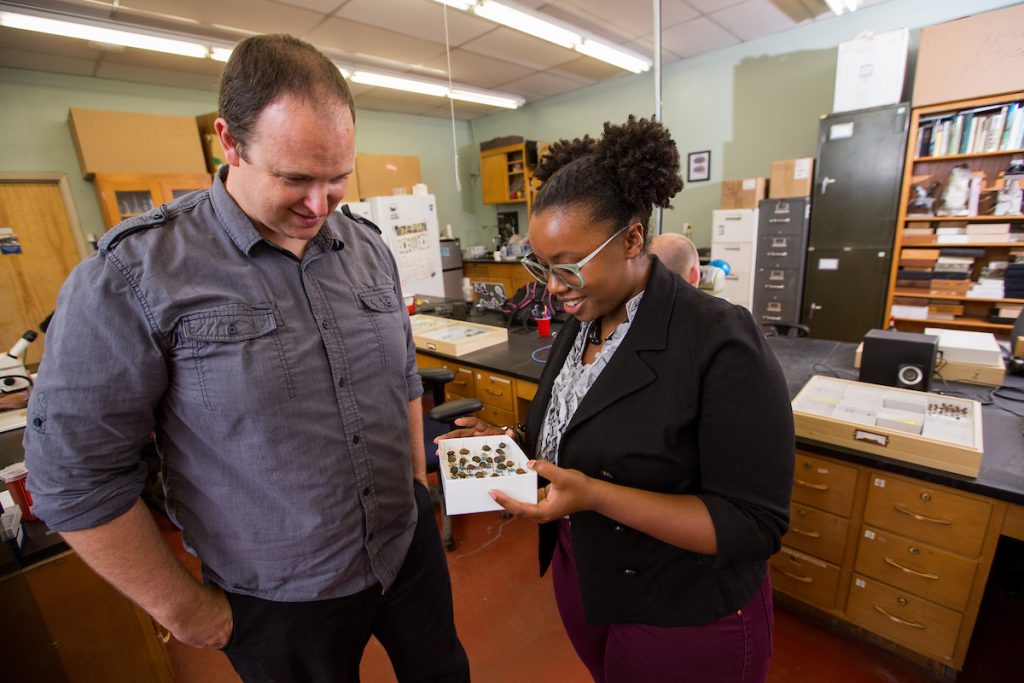By Kerry Bennett
Office of the Vice President for Research
From the blue death-feigning beetle of the American Southwest to the fog-basking beetles found in the Namib Desert of southern Africa, darkling beetles inhabit deserts all over the world. More than 20,000 different species have been identified, but thousands more are still awaiting discovery. And scientists have yet to fully understand their evolutionary history.
With $879,000 in funding from the National Science Foundation, Northern Arizona University entomologist Aaron Smith recently embarked on a major study that seeks to advance scientific understanding of these remarkable insects, including their phylogeny, evolutionary history and global biodiversity patterns.
“This project will resolve centuries-old issues in our understanding of desert darkling beetles,” Smith said.
By generating DNA data using high-throughput sequencing for the darkling beetle Pimeliinae, the researchers will reconstruct a phylogeny, or evolutionary history, that will inform taxonomic decisions and help place current distributions and life histories within an evolutionary context.
“Darkling beetles are an incredibly species-rich and morphologically diverse family,” Smith said. “Despite their ubiquity in deserts across the world, however, current understanding of their evolutionary relationships and biogeographic history is extremely limited.”
The research will result in a revision of the higher-level classification of the subfamily; an extensive knowledge base of its evolutionary ecology and biogeography; and explorations of the beetles’ abilities to adapt in diverse ways to arid habitats across evolutionary time. Some darkling beetles live as long as 10 years—a very long time for an insect—and Smith wants to find out why.
“This research will also have implications for understanding patterns of past climate change and adaptations that have enabled darkling beetles to survive in many of the harshest habitats on Earth,” he said.
Project to provide student research opportunities at NAU and in Namibia
A key element of the project is training new researchers. Smith will mentor a postdoctoral researcher in all aspects of the project; supervise two Ph.D. students, whose research development will include cross-disciplinary training; and provide research opportunities and ongoing mentoring for at least 12 undergraduate students.
“Additional students will be trained through a hybrid learning course at NAU and Namibia’s renowned Gobabeb Research & Training Centre, offering courses in systematic entomology, systematic botany and biogeography,” Smith said.
Establishing partnerships with African scientists and students
Smith and his team will establish partnerships with African scientists and students, particularly in Namibia and South Africa, to develop research skills locally and disseminate data more broadly to researchers and the public. Participants in the study will help grow well-identified synoptic collections for Gobabeb, the National Museum of Namibia and the Ditsong Museum of Natural History in South Africa.
Researchers to produce an open-access electronic monograph
Another objective of the project is to produce an open-access electronic monograph of the subfamily using a bioinformatics platform and a matrix-based approach to coding and organizing morphological characters for descriptions. The monograph will include the first worldwide key to the Pimeliinae tribes and subtribes, images of specimens and characters, distribution maps and an extensive catalog of darkling beetle names and literature.
An assistant professor of biology, Smith joined NAU in 2014. The Smith Insect Biodiversity Lab conducts collaborative research to understand patterns of biodiversity and aid in the discovery and delimitation of insect species, the world’s most diverse group of multi-cellular organisms. Smith’s team works to promote public awareness of insect diversity and species conservation. Smith also serves as curator of the Colorado Plateau Museum of Arthropod Biodiversity.



